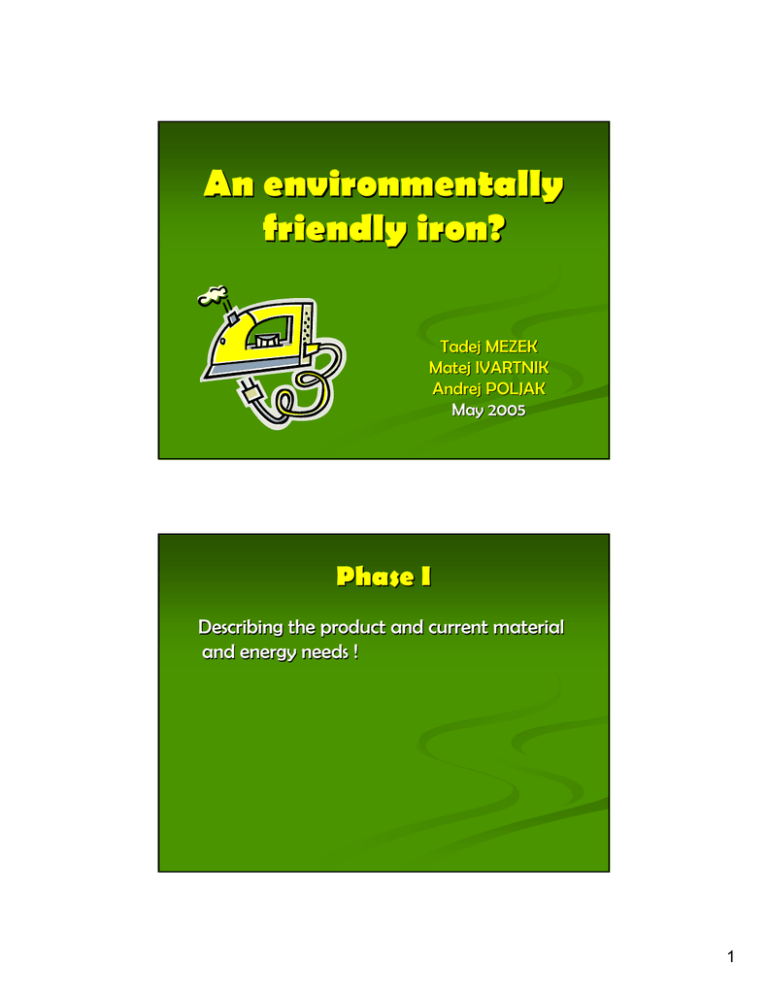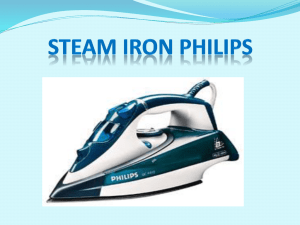An environmentally friendly iron?
advertisement

An environmentally friendly iron? Tadej MEZEK Matej IVARTNIK Andrej POLJAK May 2005 Phase I Describing the product and current material and energy needs ! 1 Introduction There are about 700 000 households (est.) in Slovenia and about the same number of irons (est. 1 iron/household). Ironing days are Saturday and Sunday and it is mostly made by women (approx. 2h per week - 3 family members). Average lifetime of iron is about 4 years. New irons come with a one-year warranty. Introduction (cont’d) Our iron was made by Rowenta-elma, about 15 years ago. The iron consists of 32 different materials (117 components) & weights 1.369 kg total and 1.155 kg net. Most of it is made out of steel, metals and many types of unlabeled plastic. It is designed for 1000 W at 220 V. 2 Disassembling the iron Disassembly took us 45 minutes (3 persons) Note: No professional disassembly tools and skills Iron measurements 3 Disassembling the iron (cont’d) Bellow you can see a picture of tiny little parts and of the disassembly procedure Disassembly-chart for iron material-component # pieces Total weight (g) box (package, carton) with instructions 6 214 plastic type 01 3 158 plastic type 02 - bakelite 5 106 70 plastic type 03 1 plastic type 04 1 12 plastic type 05 1 15 plastic type 06 1 4 plastic type 07 3 1 other plastics (7 different types) 14 45 Steel - large piece 2 494 other steel 14 25 metal screws 28 32 small metal pieces 14 51 wire (3 different types) 9 82 38 aluminum 1 rubber (4 different types) 10 6 Fabric 4 16 TOTAL 117 1 369 4 Packaging 15.6% of the total weight is packaging and wrapping (cardboard insets, no plastic in our model). Newer types of irons are packed in carton boxes made of 90% recycled material. Recycling potential Most parts are metal and plastics and therefore offer significant recycling potential. Easy disassembly with proper tools No available data about precise percentage of iron recyclability 5 Recycling potential of different iron parts Recyclable Not recyclable Plastic (polypropylene, polyester, acetal resin, polycarbonate) Aluminum for soleplate Stainless steel for soleplate sheet Small metal pieces (iron) Cardboard and paper Heating element made of iron, magnesite and nickel copper wire Silicone for different seals Cord connection and internal wires made of different raw materials materials are recyclable in part. Source - BSH Hišni aparati d.o.o. (Slovenian company which produce irons and other domestic electrical appliances for Bosch, Siemens, Ufesa and Gorenje) Market Export-import data shows that there were 33 163 irons exported from Slovenia (in a radius of about 1 000 km) and 161 650 irons were imported from all around the globe (yearly). As we have some domestic producers, we estimated an annual market to be close to 200 000 irons sold per year (the same amount of old ones as well). 6 Materials saved Two basic materials in our iron are steel and plastics. Packaging, too, is important (15.6% of total weight). If steel were 100% recycled, 129.8 tons of iron ore, 51.9 tons of coal and 20.8 tons of limestone would be saved annually. For the production of plastics, 164.4 tons of petroleum is used annually. If packaging were 90% recycled, 655 trees, 387 550 kWh of electricity, 963 m3 of water and 98.99 m3 of oil would be saved annually. - Numbers of irons sold in Slovenia every year (200 000) Environmental impacts materialmaterial-component Total weight (g) Energy required (kJ) if from primary source for our given mass for one Iron Energy required (kJ) if from recycled source for our given mass for one Iron Total energy required (MJ) if from primary source for iron in Slovenia Total energy required (MJ) if from recycled source for iron in Slovenia Plastics (various types) 411 39 045 20 550 27 331 500 14 385 000 Steel pieces 519 20 760 9 394 14 532 000 6575800 Other metal pieces 83 2 822 1 992 1 975 400 1394400 Copper (wire) 82 4 920 3 690 3 444 000 2583000 Aluminum 38 7 448 1 015 5 213 600 710500 Rubber (4 different types) 6 406 406 284 200 284200 Fabric 16 1 920 515 1 344 000 360500 TOTAL 1 155 75 401 37 047 52 780 700 25 932 900 Note: Cardboard and wrapping is omitted. 7 Environmental impact and energy production in Slovenia Thermoelectricity production in Slovenia accounts for 33% of the total electricity production, which means: 13 kg of coal consumption per iron per household (3 persons) in one year 14 kg of CO2 emission per iron per household yearly 0.03 kg of SO2 emission per iron per household in one year. Total of 9100 tons of coal consumption, 9 800 tons of CO2 and 21 tons of SO2 emissions due to iron use in Slovenia! Slovenia! SourceSource- Center of Energy and Environmental Technologies, Faculty of Mechanical Mechanical Engineering, University of Ljubljana, Slovenia Environmental impact during use One iron uses 50 kWh of energy annually for domestic use in a household of 3 persons (25 kWh for 1 person in household, 66 kWh for 4 persons in household). That means: 126 000 000 MJ of energy annually for all ironing done in Slovenia . 50 kWh*3 600 s* 700 000 irons = 126 000 000 MJ. Source – Center of Energy and Environmental Technologies, Faculty of Mechanical Mechanical Engineering, University of Ljubljana, Slovenia 8 Comparing energy used Production phase: 52 780 700 MJ (if no recycling) 13 195 175 MJ per year (considering lifetime of 4 years) 15 080 200 MJ per year (considering 200 000 sold annually) 14 137 687.5 MJ per year (average) Use phase: 126 000 000 000 MJ per year Energy used in production and use phase of iron use production Conclusions Irons are big energy consumers, and, comparing the numbers for production and use, the redesign should obviously be oriented toward the use phase, because almost 9 times more energy is used in that phase than in production. Knowing that no energy conversion can achieve 100% efficiency, a 10% improvement in energy conversion would save almost as much energy as whole production phase needs. 9 Phase II Redesign – How to save on material and energy ? Introduction There is a large potential of energy savings in the use phase, but a 10% increase in efficiency is much more than it seems and probably cannot be achieved. Still we tried to find ways where the largest savings could be done – some quite unreasonable and others already done. 10 Redesigning the iron - Redesign process 1. ELIMINATE THE PROCESS – STOP IRONING Why is ironing needed? To smooth and disinfect the clothes. Nowadays clothes are washed so well that there is no more disinfection needed and ironing has only an aesthetic function. It is also hard to say that ironing is free or fun time for anybody. DEEP…………….....…LYFESTILE CHANGE Redesigning the iron - Redesign process 2. CHANGE THE PROCESS – NEW TYPE OF SMOOTHING DEVICE We could use an alternative smoothing process like “ironing” with blowing hot air on and inside the clothes. It requires less time and effort to do the same job. But is this alternative environmentally friendlier than the old ironing process? DEEP……………………DEVICE SUBSTITUTION 11 Redesigning the iron Redesign process 3. IMPROVE ENERGY CONVERSION MAKING IRONS Change steel with better materials for heat conduction and heat maintenance. It is actually possible to use more material to save on overall energy consumption (ex. cooking pots with massive bottom) but would it work on irons? SHALLOW………PRODUCT CHANGE Redesigning the iron Redesign process 4. INTRODUCE IRONING SERVICES – REDUCE THE NUMBER OF IRONS Laundry services are well known already and after washing they also iron your laundry – good in principle but there is the transport issue. Possibility is also maid ironing laundry for more clients with one iron at their home – service that comes to home. In buildings with more flats also laundry and ironing room for all the residents could be organized. MODERATE……..………DEMATERIALIZATION 12 Redesigning the iron Redesign process 5. MAKE SOME COMPONENTS OF IRON EXCHANGEABLE Ironing plates and water tanks could be produced in ways that easy replacement would be possible, so when broken, only parts and not the whole iron should be changed. Also, by using different plates, the process could be adjusted to the fabric being ironed and temperature used so energy would be saved. DEEP/MODERATE…… …REUSE/PRODUCT CHANGE DEEP/MODERATE……....… Redesigning the iron Redesign process 6. IMPROVE IRON ENERGY EFFICIENCY WITH HELP OF ELECTRONICS There are already thermoregulators in irons for auto switch off when the desired temperature is reached, but other improvements could also be made: auto switch off when no contact with ironing table for 30 seconds, auto adjust temperature to fabric. MODERATE……… PRODUCT CHANGE MODERATE………PRODUCT (IMPROVEMENT) 13 Redesigning the iron Redesign process 7. USE ONLY ONE TYPE OF SIMILAR MATERIAL By using only one type of plastics, steel, rubber etc., the product would gain on recycling potential. SHALLOW………….....................RECYCLING Redesigning the iron Redesign process 8. MARK ALL MATERIALS IN IRON WITH TYPICAL CODES The sorting by disassembly would go faster, and recyclable materials could be better recycled. SHALLOW…............DISASSEMBLY/RECYCLING 14 Conclusions Irons and other electric appliances are part of everyday life and need a lot of energy during there lifetime. So, life cycle analysis should be performed and production should probably focused on reducing energy needs in use phase. In longer lasting and continuously running appliances a lot on energy saving has already been done and some principles could be copied to irons. Of course the use of materials for greater recycling potential can also not be forgotten. Finally suggestions Some tips that help conserve energy during ironing: Plug on your iron only after you get all your clothes together. Sort your clothes by type of fabric. First you have to iron delicate clothes that need lower temperatures than clothes which need higher temperatures. It is easier and faster to iron with steam type irons; they save energy. During longer breaks, switch off the iron. 15 16




